ISSN ONLINE(2319-8753)PRINT(2347-6710)
ISSN ONLINE(2319-8753)PRINT(2347-6710)
Mohamed Ali Abdulsalam1, Hamza Jaber Mohamed2, Miftahul Anwar3, Muhammad Nizam4
|
| Related article at Pubmed, Scholar Google |
Visit for more related articles at International Journal of Innovative Research in Science, Engineering and Technology
The aim of this research is to evaluate day-lighting levels for Office Buildings that utilises Double Glazed Facades-DGF. The main objectives are to study the day-lighting characteristics inside the cavity at different cavity depths in double skin facade office to find a good lighting, and effects of varying window areas on day-lighting behaviours with sensor height grid 0.700 m. The study also involves the analysis of Inlux on the weather data for Jakarta. The simulations were done using the building simulation software ECOTECT, whereas the protocol was applied to an experimental study of north-facing model with exterior full glass wall and the interior wall with different size windows from 10% to 100% window to wall ratio. Where compared the day lighting levels to verify from the results that got from ECOTECT software by using DIALUX software under the same sky condition (overcast sky), the results were not very different under overcast sky in ECOTECT 469 lux and DIALUX 482 lux. However it can be concluded that the daylight - DL decreases with the increase in the cavity depths and increases with the increase in the window sizes. The comfortable day-lighting levels are found when the window size is not more than 50% window wall ratio (WWR) and the cavity depth is not bigger than 1m.
Keywords |
| DGF, Ecotect, Dialux day-lighting factors & day-lighting levels. |
INTRODUCTION |
| Introducing natural light into buildings saves energy and also creates an attractive environment that improves the well-being of its occupants. The provision of effective daylight in buildings can be assessed using average daylight factors and by ensuring that occupants have a view of the sky. The average daylight factor will be influenced by the size and area of windows in relation to the room, the light transmittance of the glass, the brightness and colour of the internal surfaces and finishes, the depth of reveals, and the presence of overhangs and other external obstructions which may restrict the amount of day lighting entering the room Gunawan et al. [1]. Day lighting has a significant role in the field of renewable energy to reduce energy consumption. It is estimated that buildings are the main source of CO2 emissions where 46%, 71%, and 50% of total energy is consumed in buildings of South Korea, USA, and Hong Kong, respectively. Electric lighting energy utilization in buildings is 40–50% of the total energy cost. One of the principles of sustainable buildings is to utilize daylight at all day for lighting. Buildings that include daylight with lighting control system, which maintains light level in the interior space, are estimated to reduce electric lighting energy consumption by 50–80% Ullah [2] The building envelope serves to separate the interior and the exterior environments and plays an important role in solar heat gain management, thermal load control, air infiltration and, ventilation, noise control, design quality and aesthetic definition. A significant portion of the total primary energy is consumed by today's buildings in developed countries. In many of these buildings, the energy consumption can be significantly reduced by adopting energy efficiency strategies. Due to environmental concerns and the high cost of energy in recent years there has been a renewed interest in building energy efficiency. This article strives to make an exhaustive technical review of the building envelope components and respective improvements from energy efficiency perspective. Different types of energy efficient walls such as Trombe walls, ventilated walls, and glazed walls Sadineni et al. [3]. Heat gain from solar energy through Trombe wall in Turkey. The wall materials, reinforced concrete, brick and autoclaved aerated concrete, were taken into consideration with various surface colors. Ozbalta & Kartal. [4]. This study aimed to show that the basic thermal performance of double skin facade in Istanbul double skin facade has a great effect on building’s heat loss. Different glass types, different transparency ratio and components different thermal properties will give different results. YÃâñlmaz & Cetintas. [5]. |
DAYLIGHT |
| Day lighting has often been recognized as a useful source of energy savings and visual comforts in buildings. Occupants expect good daylight in their working spaces. The quality and quantity of natural light entering a building depend on both internal and external factors. Danny &Tsang. [6]. Daylight or natural light is visible radiation which is generated by the sun. It can reach in three different ways: |
| Direct solar component. |
| Externally reflected component. |
| Internally reflected component. |
| The solar radiation incident on a building is made up of following components: as shown in Figure 1 |
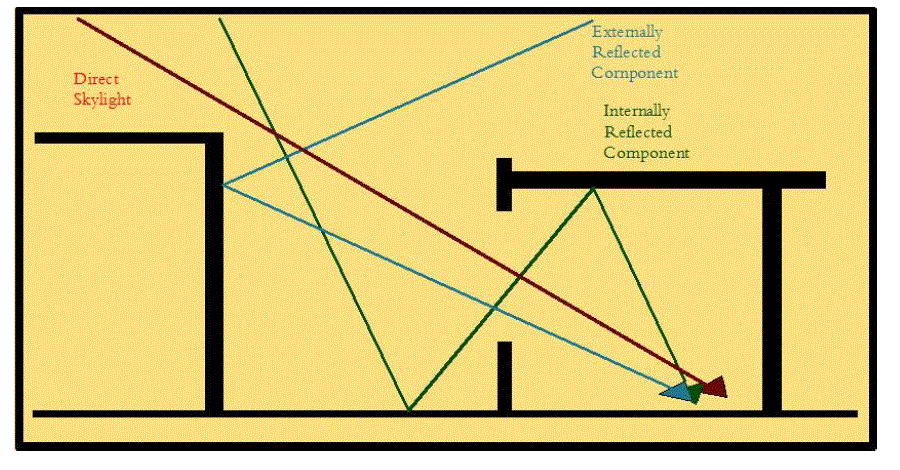 |
| A. Daylight Factor |
| Daylight factor is the ratio between indoor illuminance and outdoor illuminance. It can be measured for a specific point or for an average of a space. The following formula shows how to calculate daylight factor from illuminance levels |
| DF = 100 * Ein / Eext (1) |
| Where |
| Ein: indoor illuminance level |
| Eext: outdoor illuminance level |
| By definition, daylight factor should be only calculated under the CIE overcast sky condition. This is critical for the understanding of the final simulation results. An overcast sky does not take into account the direct light entering a space, so rotating a building to face different directions (for example, north, south, eastt and west) will not significantly change the calculations. Kensek & Suk [7]. For defining access to daylight a method called the Daylight Factor (DF) is used. The Daylight Factor (DF) is a numerical ratio used to describe the relationship between indoor and outdoor daylight illuminances (usually under overcast sky conditions). Gunawan et al [1]. There are two approaches for accessing daylight: |
 |
| Where |
| EI: indoor illuminance level |
| EO: outdoor illuminance level |
| For Indonesia: |
 |
| B. CIE Clear Sky vs. CIE Overcast Sky |
| Although the sky is changing every minute of a day, typically average sky conditions are used for day lighting calculations. Different models of virtual skies have been developed by the CIE and others. CIE has mathematically developed 15 different sky conditions, two of which are shown in Figure 2.2. Among these sky conditions, overcast and clear skies have been widely used in day lighting simulations all over the world. Although the sky is changing every minute of a day, typically average sky conditions are used for day lighting calculations. Different models of virtual skies have been developed by the CIE and others. CIE has mathematically developed 15 different sky conditions, two of which are shown in Figure 2.2. Among these sky conditions, overcast and clear skies have been widely used in day lighting simulations all over the world. With completely cloudy sky (100% covered), this sky model has been widely used to calculate daylight factor. Many designers and users have used this model to calculate the worst case scenario. Ecotect software uses this sky model as a default. CIE clear sky is defined by having less than 30% of clouds covering the sky or no clouds. In either case, the sky is brighter towards the location of the sun, and the sun is visible. Direct sunlight can be considered and calculated inside a building. This model is useful when visual glare and thermal discomfort studies are performed. For predominated sunny climate areas such as Los Angeles and Phoenix, this sky model should be considered in day lighting calculations However, there are many different types of sky and many different mathematical models used to describe them. Kensek & Suk. [7] |
| C. Design Sky |
| The sky that is considered in the design of buildings in terms of illumination is termed as the Design Sky. Its values are dependent on the dynamic conditions of the outdoor sky illuminance levels and are derived from the statistical analysis of these conditions. In the designing stage of buildings, the Design Sky is represented by the horizontal illuminance value. This value exceeded 85% of the daylight time between the hours of 9am and 5pm throughout the year. This particularly time frame and sky illumination value represent a worst-case scenario for designing of buildings. This is to ensure that the building meets the desired light levels of at least 85% of the time. The Design Sky values vary from around 12-15,000 lux at the equator down to around 3000-4000 lux at latitude of ±60 Fine et al. [8]. |
METHODS |
| This research topic started by testing a simple room with overcast sky condition and comparing the illuminance levels to verify what assumptions were being made about the sky condition. The following programs were used: Ecotect (case#1) and Dialux (case#2) Design (lighting analysis).The relationship between day lighting levels (DL) and window to wall ratio (WWR) is ranged from 10% up to 100% at different cavity depths to find good lighting. The office has a double facade window and the cavity depth measurements are 4.0 m wide, 3.2 m high and 6.0 m length and 0.5: 2.0 m deep with full glass exterior facade with a window varied from 10% to 100% internal of the window wall ratio (WWR) as shown in Figure 2, 3 below. Guidelines for energy efficiency in buildings recommend that the interior lighting level for office building should be between 300 to 500 lux. For this study we used the maximum allowable interior lighting level 500 lux. Hamza et al. [9]. |
RESULTS |
| Daylight parameters: Location: Jakarta, Longitude: 106.80°, Latitude: -6.20°, North deviation: 180.0°Date: 23.09.2013, Time: 10:28:00 (+7 hours difference to GMT) Reference sky type: Overcast Sky. |
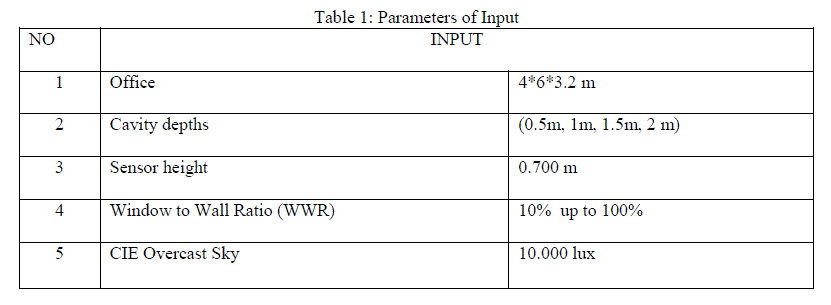 |
| ECOTECT (Case #1) |
| A simple room was built with two glass walls as described above. |
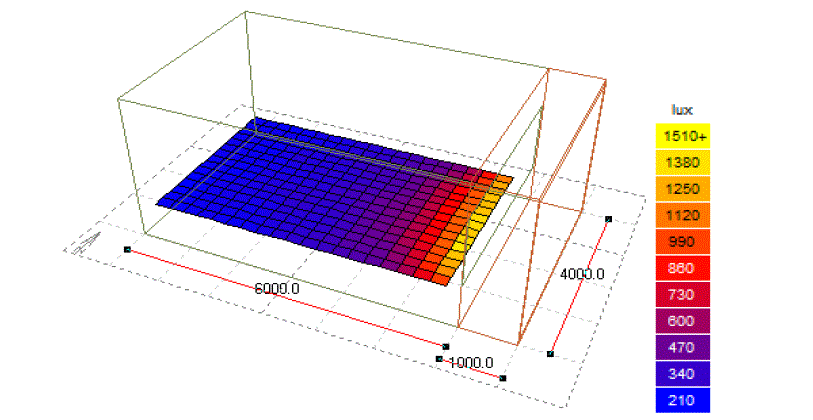 |
| Figure 2 Section view under CIE overcast sky North deviation: 180.0 at 10:28:00 AM |
| DIALUX (Case # 2) |
| Dimensions is same as case #1 |
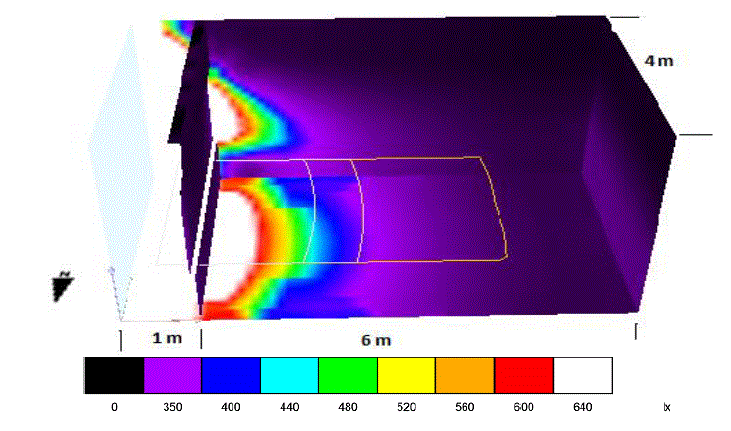 |
| To better understand the results, the lighting levels are shown in Excel graphs. |
| Case #1 |
| Figure 4 shows the average of inlux day lighting levels inside the office at different cavity depths, and the distance between each averages are similar, however the day lighting levels increases gradually with increasing the size of the window and decreases with increasing the size of the cavity and the optimal window size found when the window sizes are not more than 50% WWR and when the cavity depth is not bigger than 1m. |
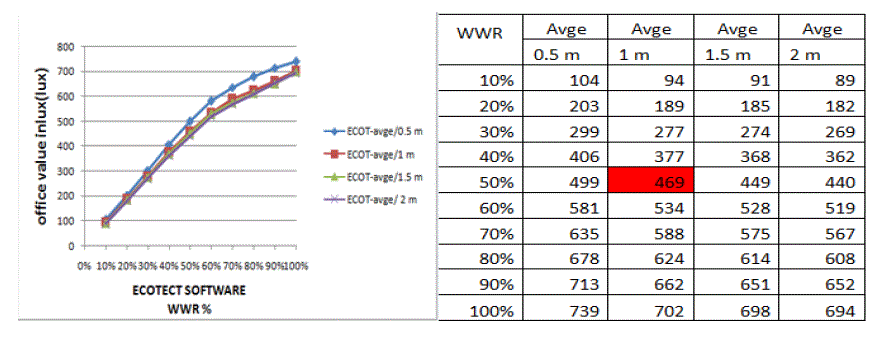 |
| Case # 2 |
| Figure 5 shows the average of inlux day lighting levels inside the office at different cavity depths and the distance between each averages are big. The results are not very different under overcast sky. DIALUX shows 482 lux higher light levels. However the day lighting levels increases gradually with increasing the size of the window and decreases with increasing the size of the cavity and the optimal window size found when the window sizes are not more than 50% WWR and when the cavity depth is not bigger than 1m. |
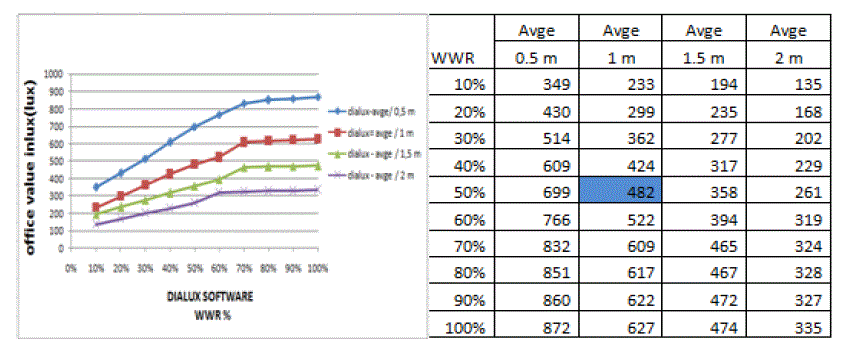 |
| For comparison we put the averages of figure 4 & 5 to figure 6 As shown in figure 6 under overcast sky the daylighting levels inside the office is affected with the increase of cavity sizes in all two software programs. However the comfortable day-lighting levels are found when the window sizes are not more than 50% WWR and when the cavity depth is not bigger than 1 m. However, the results are not very different under overcast sky. DIALUX shows 482 lux higher light levels. And ECOTECT shows 469 lux. This means that if DIALUX is used for day lighting analysis, it would be easier to get higher predicted light levels than the other software programs. |
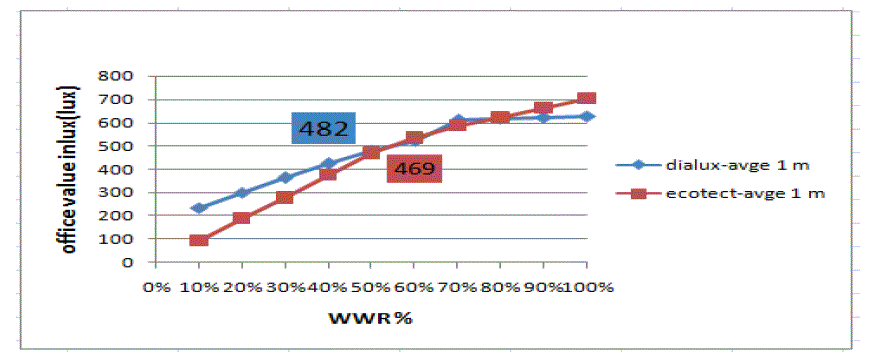 |
CONCLUSION |
| The knowledge of the day-lighting behavior of the proposed facade which constitutes the basis for the day-lighting levels analysis of buildings was studied. The investigation was conducted in a cavity office with a double glazed facade exposed towards the southern direction in a building located in Jakarta. The results indicate that the day-lighting levels components are strongly influenced by increment or decrement of the cavity depths and window sizes found by using ECOTECT software. Most of the incoming outlux from the daylighting into the glass were reflected and refracted inside the cavity depth of the office. The results have also show that the day lighting levels is affected by many factors such as increasing in the cavity depths and window sizes. The analysis was conducted on four different cavity depths, from 0.5m up to to 2m, where the comfortable day-lighting levels inside the office with sensor 0.700 m height found when the size of window is not more than 50% and when the cavity depth is not bigger than 1m. The result of day lighting levels was 469 lux. |
| Where compared the illuminance levels to verify from the results that got from ECOTECT software by using DIALUX software under the same sky condition (overcast sky) the results were not very different under overcast sky. In ECOTECT 469 lux and DIALUX 482 lux.It can be concluded that increases in the cavity depths lead to the decrease of the day-lighting levels. Furthermore, it can be summarised that: |
| 1. The DL levels indicate a high value at the beginning of the cavity where it then indicate lower and lower DL values until the end of the cavity. |
| 2 The optimal DL values were recorded at the window sizes from 40% up to 50% WWR for 1 m, 1.5 m and 2 m cavity depths. |
| 3 The comfortable day-lighting levels are found when the window sizes are not more than 50% WWR and when the cavity depth is not bigger than 1m. |
References |
|